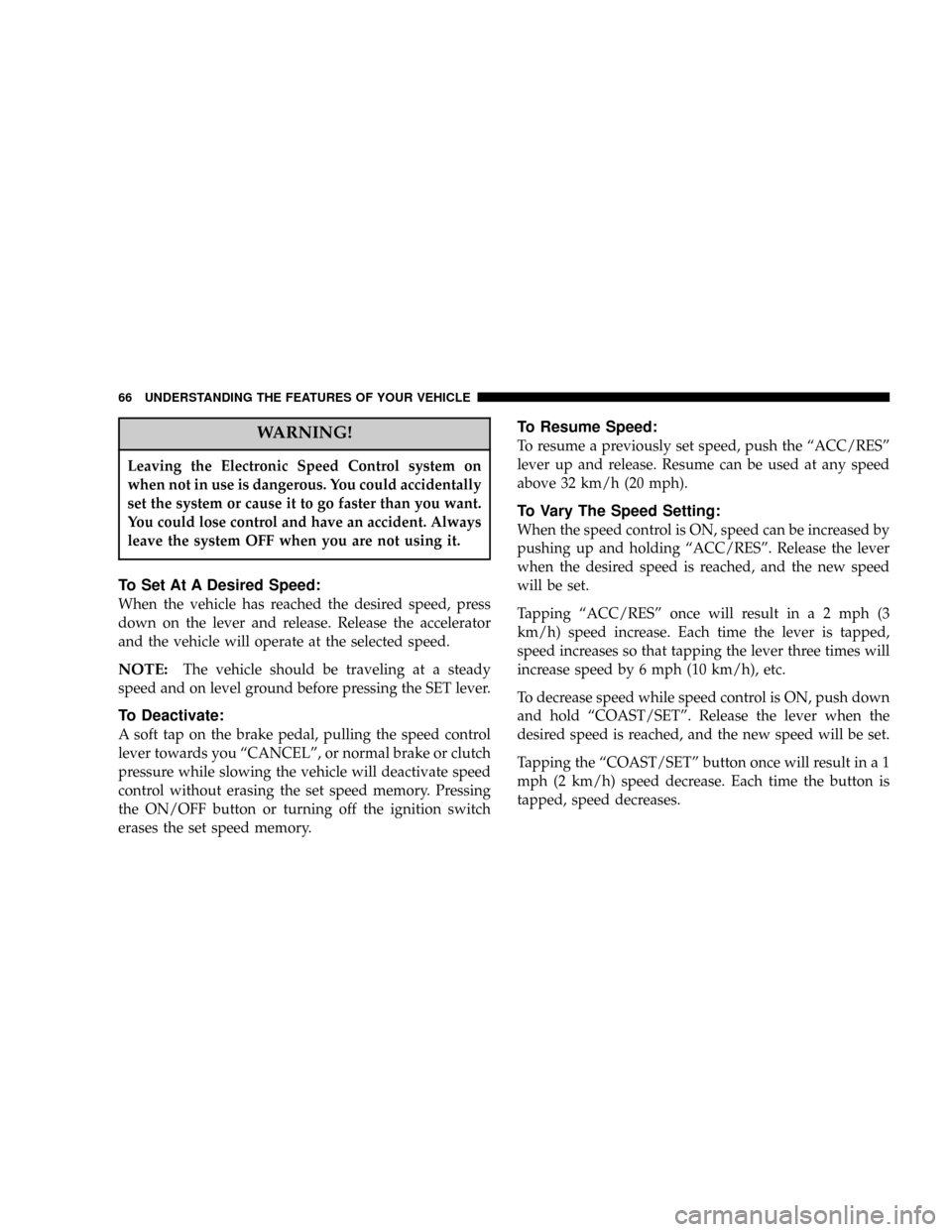2005 DODGE NEON clutch
[x] Cancel search: clutchPage 66 of 246

WARNING!
Leaving the Electronic Speed Control system on
when not in use is dangerous. You could accidentally
set the system or cause it to go faster than you want.
You could lose control and have an accident. Always
leave the system OFF when you are not using it.
To Set At A Desired Speed:
When the vehicle has reached the desired speed, press
down on the lever and release. Release the accelerator
and the vehicle will operate at the selected speed.
NOTE:The vehicle should be traveling at a steady
speed and on level ground before pressing the SET lever.
To Deactivate:
A soft tap on the brake pedal, pulling the speed control
lever towards you ªCANCELº, or normal brake or clutch
pressure while slowing the vehicle will deactivate speed
control without erasing the set speed memory. Pressing
the ON/OFF button or turning off the ignition switch
erases the set speed memory.
To Resume Speed:
To resume a previously set speed, push the ªACC/RESº
lever up and release. Resume can be used at any speed
above 32 km/h (20 mph).
To Vary The Speed Setting:
When the speed control is ON, speed can be increased by
pushing up and holding ªACC/RESº. Release the lever
when the desired speed is reached, and the new speed
will be set.
Tapping ªACC/RESº once will result in a 2 mph (3
km/h) speed increase. Each time the lever is tapped,
speed increases so that tapping the lever three times will
increase speed by 6 mph (10 km/h), etc.
To decrease speed while speed control is ON, push down
and hold ªCOAST/SETº. Release the lever when the
desired speed is reached, and the new speed will be set.
Tapping the ªCOAST/SETº button once will result in a 1
mph (2 km/h) speed decrease. Each time the button is
tapped, speed decreases.
66 UNDERSTANDING THE FEATURES OF YOUR VEHICLE
Page 67 of 246

Manual Transaxle:
Depressing the clutch pedal will disengage the speed
control. A slight increase in engine RPM before the speed
control disengages is normal.
Vehicles equipped with manual transaxles may need to
be shifted into a lower gear to climb hills without speed
loss.
WARNING!
Speed Control can be dangerous where the system
can't maintain a constant speed. Your vehicle could
go too fast for the conditions, and you could lose
control. An accident could be the result. Don't use
Speed Control in heavy traffic or on roads that are
winding, icy, snow-covered, or slippery.
To Accelerate For Passing:
Depress the accelerator as you would normally. When the
pedal is released, the vehicle will return to the set speed.
Using Speed Control On Hills
NOTE:
The speed control system maintains speed up
and down hills. A slight speed change on moderate hills
is normal.
Vehicles equipped with four speed automatic transaxles
may experience a downshift to 3rd gear while climbing
uphill or descending downhill. This downshift to 3rd
gear is necessary to maintain vehicle set speed.
On steep hills a greater speed loss or gain may occur so
it may be preferable to drive without speed control.
UNDERSTANDING THE FEATURES OF YOUR VEHICLE 67
3
Page 114 of 246

STARTING PROCEDURES
Before starting your vehicle, adjust your seat, adjust both
inside and outside mirrors, and fasten your seat belts.
CAUTION!
Long periods of engine idling, especially at high
engine speeds can cause excessive exhaust tempera-
tures which can damage your vehicle. Do not leave
your vehicle unattended with the engine running.
WARNING!
Do not leave children or animals inside parked
vehicles in hot weather. Interior heat build up may
cause serious injury or death.
Automatic Transaxle
The gear selector must be in the NEUTRAL or PARK
position before you can start the engine.
NOTE:You must press the brake pedal before shifting
out of Park.
Manual Transaxle
Place the gear selector in NEUTRAL, press the clutch
pedal to the floor, and fully apply the parking brake
before starting the engine.
NOTE:The engine will not start unless the clutch pedal
is pressed to the floor.
Normal Starting
Normal Starting of either a cold or a warm engine does
not require pumping or depressing the accelerator pedal.
Simply turn the key to the START position and release
when the engine starts. If the engine has not started
within 5 seconds, slightly depress the accelerator pedal
while continuing to crank. If the engine fails to start
within 15 seconds, turn the key to the OFF position, wait
10 to 15 seconds, then repeat the normal starting proce-
dure.
114 STARTING AND OPERATING
Page 119 of 246

When frequent transaxle shifting occurs while using the
Overdrive range, such as when operating the vehicle
under heavy loading conditions (in hilly terrain, travel-
ing into strong head winds, or while towing trailers), use
the ª3º range.
ª3º Drive
This range eliminates shifts into Overdrive. The transaxle
will operate normally in first and second while in this
range.
NOTE:Using the ª3º range while operating the vehicle
under heavy operating conditions will improve perfor-
mance, fuel economy, and extend transaxle life by reduc-
ing excessive shifting and heat build up.
Use the ª3º range when descending steep grades to
prevent brake system distress.
ª1º Low
This range should be used for maximum engine braking
when descending steep grades. In this range, up shifts
will occur only to prevent engine over speed while down
shifts from 2nd to first will occur as early as possible.
MANUAL TRANSAXLE Ð IF EQUIPPED
NOTE:
The parking brake should be engaged and the
gear selector placed in REVERSE before leaving the
vehicle, especially on an incline.
NOTE:Clutch must be depressed for engine to start.
Fully depress the clutch pedal before you shift gears. As
you release the clutch pedal, lightly depress the accelera-
tor pedal.
Use each gear in numerical order - do not skip a gear. Be
sure the transaxle is in FIRST gear, (not THIRD), when
starting from a standing position. Damage to the clutch
can result from starting in THIRD.
For most city driving you will find it easier to use only
the lower gears. For steady highway driving with light
accelerations, 5th gear is recommended.
Never drive with your foot resting on the clutch pedal, or try
to hold the vehicle on a hill with the clutch pedal partially
engaged. This will cause abnormal wear on the clutch.
Never shift into REVERSE until the vehicle has come to a
complete stop.
STARTING AND OPERATING 119
5
Page 121 of 246

CAUTION!
If you skip more than one gear while downshifting
or downshift at too high an engine speed, you could
damage the engine, transaxle, or clutch.
To maintain a safe speed and prolong brake life, shift
down to 2nd or 1st when descending a steep grade.
When turning a corner, or driving up a steep grade, shift
down early so that the engine will not be overburdened.
PARKING BRAKE
When the parking brake is applied with the
ignition on, the Brake Light in the instrument
cluster will come on.
NOTE:This light only shows that the parking brake is
on. It does not show the degree of brake application.
Before leaving the vehicle, make sure that the parking
brake is set. To set the parking brake, pull up firmly on
the lever. Also place the gear selector in the Park position
(automatic transaxle) or Reverse (manual transaxle). Torelease the parking brake, apply the brake pedal and pull
up on the parking brake lever. Push the release button
and lower the lever fully.
When parking on a hill, it is important to set the parking
brake before placing the gear selector in Park, otherwise
the load on the transmission locking mechanism may
make it difficult to move the selector out of Park. As an
added precaution, turn the front wheels toward the curb
on a downhill grade and away from the curb on a uphill
grade.
Parking Brake Lever
STARTING AND OPERATING 121
5
Page 147 of 246

Trailer Towing Information (Maximum Trailer
Weight Ratings)
(Trailer Towing Guide(
NOTE:
For trailer towing information (maximum
trailer weight ratings) refer to the following website
address:http:// www.dodge.com/towing.
In Canada, refer to the following website address:
http:// www.dodge.ca.
Warranty
To maintain warranty coverage, follow the requirements
and recommendations in this manual concerning ve-
hicles used for trailer towing. However the following
conditions must be met:
²The maximum trailer load for vehicles with the Stan-
dard 2.0L Engine and manual tranaxles is 1,500 lbs
(680 kg).
²The maximum trailer load for vehicles with the Stan-
dard 2.0L Engine and automatic transaxles is 1,000 lbs
(454 kg).
²If using a manual transaxle vehicle for trailer towing,
all starts must be in FIRST gear to avoid excessive
clutch slippage.
²The maximum frontal area of the trailer cannot exceed
20 square feet (1.86 square meters).
²The trailer tongue load must be considered as part of
the combined weight of occupants and cargo, and
should never exceed the weight referenced on the Tire
and Loading Information placard. Refer to the Tire±
Safety Information Section in this manual.
²The ªDº range can be selected when towing. However,
if frequent shifting occurs while in this range, the ª3º
range must be selected.
NOTE:Using the ª3º range while operating the vehicle
under heavy operating conditions will improve perfor-
mance and extend transaxle life by reducing excessive
shifting and heat build up.
STARTING AND OPERATING 147
5
Page 196 of 246

MAXI
FUSEAmp/Color Items Fused
1Ð Ð
2Ð Ð
3 40 Amp/
GreenHeadlamps
4 40 Amp/
GreenIgnition Run
5 30 Amp/Pink ABS Solenoid
6 30 Amp/Pink Radiator Fan
7 Spare
8 40 Amp/
GreenABS Pump
9 30 Amp/Pink Starter
10 40 Amp/
GreenElectric Back Light (EBL)MINI
FUSEAmp/Color Items Fused
11 Spare
12 Spare
13 20 Amp/
YellowIOD/Int Lighting/Radio
14 20 Amp/
YellowPower Outlet
15 15 Amp/Blue Hazard Flasher
16 15 Amp/Blue MTV
17 20 Amp/
YellowElectronic Automatic
Transaxle (EATX)
18 10 Amp/Red Horn
19 Spare
20 20 Amp/
YellowFog Lamp (Export Only)
21 20 Amp/
YellowASD/Fuel Pump
22 10 Amp/Red A/C Clutch
23 15 Amp/Blue Stop Lamps
196 MAINTAINING YOUR VEHICLE